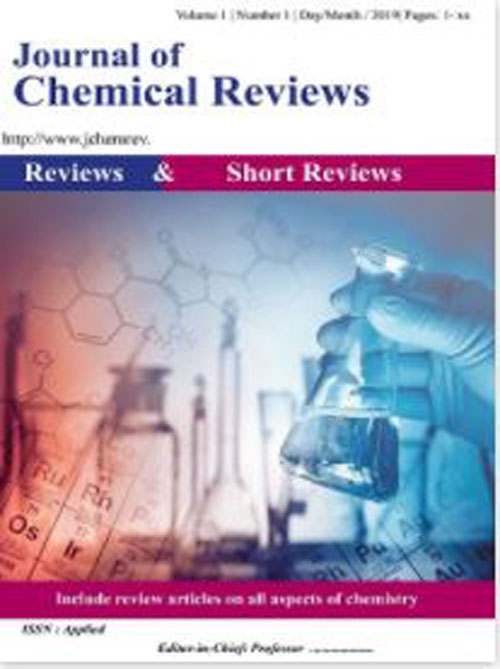فهرست مطالب

Journal of Chemical Reviews
Volume:3 Issue: 4, Autumn 2021
- تاریخ انتشار: 1400/08/23
- تعداد عناوین: 5
-
Pages 247-272
Morpholine and its thio analogue thiomorpholine are moieties with multifaceted roles, and demonstrated myriad physiological activity. This review discusses several analogues of morpholine and thiomorpholine synthesized by varied facile synthetic schemes resulting in substitution on multiple positions of the heterocycles. Both morpholine and its thio analogue have proven to act as bioactives against different molecular targets. These scaffolds have been an indispensable element of the pharmacophore and have exhibited selective enzyme inhibition against many receptors. They have also been an integral aspect of the drug discovery process. This review endeavours to condense the new trends concomitant to the various aspects of morpholine and thiomorpholine, their biological activities and their various synthetic routes.
Keywords: Morpholine, Thiomorpholine, Activity, Synthesis -
Pages 273-289
This article reviews the work done on neural networks in recent years. In recent years we have witnessed a continuous movement, from purely theoretical research to applied research, especially in the field of information processing, for problems for which there is no solution or which is not easily solved. Artificial neural networks are part of a group of dynamic systems, which, by processing experimental data, transfer the knowledge or law behind the data to the network structure. This is why these systems are called intelligent, because they learn general rules based on calculations based on numerical data or examples. These systems attempt to model the neuro-synaptic structure of the human brain. From the brain as an information processing system with a parallel and completely complex structure that makes up two percent of the body weight and consumes more than twenty percent of the body's total oxygen for reading, breathing, movement, thinking and exploring and the kidneys. Conscious actions and many unconscious behaviors are used. How the brain does these things has been around since they realized that the brain has a completely different structure for its computations than conventional computers?
Keywords: Neural Network, brain, oxygen, Dynamic systems, intelligent system -
Pages 290-306
Persistent efforts were made by various researchers to improve the quality of gas-solid fluidized bed by means of hindering the bubble formation, avoiding the coalescence of bubbles through bubble breakage, thereby exhibiting a meticulous bed expansion and fluctuation. To conquer these difficulties and to achieve a better fluidization quality use of distributor, turbulence and promoter has been recommended and emerged as an alternative and effective technique. The introduction of promoters performs well in smoothening the fluidization operation in terms of infringement of bubbles, and regulating the bubble size through inhibiting their growth. A better fluidization quality is achieved by various fluidization characteristics such as bed expansion, fluctuation, mixing index and minimum fluidization velocity. Therefore, various researchers investigated the usage of different types of promoters and distributors and recommended that by using a suitably designed promoter and distributor possess an improved fluidization quality with marginal fabrication cost, however the operational cost remains unchanged. Most of the literature studies are dealt with the qualitative effect of the usage of promoters and distributors in a gas-solid fluidized bed though investigation of various hydrodynamics characteristics viz. bed expansion ratio, bed fluctuation ratio, bed pressure drop ratio.
Keywords: Gas–solid fluidization, Distributor, Promoter, Bed expansion ratio, Fluctuation ratio, Pressure drop -
Pages 307-319
Depression has become burden to the society with millions of people suffering from annually. Symptoms of depression are including difficulties in concentration, sad mood, loss of interest, guilt, feeling of hopelessness, sleeping difficulty, restlessness, appetite loss, decreased energy, suicidal attempts among others. Therefore, the present work aimed to review the antidepressant activity of extracts from seventy six medicinal plants belonging to forty four plant families. Methodology such as open field test, force swim test, tail suspension test and beam walking assay were used for the determination of antidepressant activity in plants extracts. Different extraction techniques and solvents were utilized to extract phytochemicals from the plants materials. All information regarding the antidepressant medicinal plants in this research study were obtained from various research articles published in fifty nine Journals. The results indicated that the medicinal plants in this review possess significant antidepressant activity. These medicinal plants extracts may serve as a potential resource for natural psychotherapeutic agent against depression.
Keywords: medicinal plants, antidepressant, Extraction, Phytochemical -
Pages 320-344
Non-renewable energy sources produced from natural coal and oil may result in climate change and global warming as greenhouse gases release to the environment. This reason faces the main utilization of energy sources on renewable and alternate green energy to deliver power. Thus, microbial fuel cell device is one of the cost-effective and environmentally friendly energy conversion devices that uses renewable organic wastes as fuel source and converts this stored chemical energy in to useful bioelectricity simultaneously with treating the waste in the presence of biocatalyst. Therefore, it is the most cost effective and simple electrochemical technique that delivers renewable energies. Most of the time electrodes of fuel cells are commercialized and depends on platinum catalyst. Obviously, platinum and its family cost are so expensive. To solve this, researchers are focused on low-cost electrode materials fabrication but still they are in low performance towards wastewater and current generations. Currently, conventional carbon materials are utilized as anode electrodes in laboratory even in pilot scale microbial fuel cell system but are ineffective in their performances due to various reasons. So, to improve performances, anode electrodes were modified with nanocomposites composed from low-cost transition metal oxides and conducting polymeric materials. Therefore, in this review possible ways of transition metal oxide synthesis including green method to form composite with selective conducting polymers, composite modification of anode and its role for wastewater treatment, dye removal as well as bioelectricity generations are briefly discussed.
Keywords: Nanocomposites, Transition metal oxide, Conducting polymers, Plant extract, Microbial fuel cell

